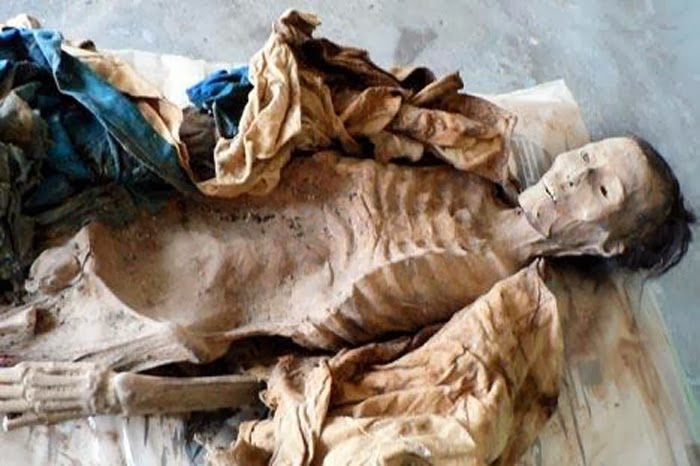
Ancient clothing from the Xinjiang mummies
Chinese archaeologists have carefully stripped the 2,200-year-old clothing from four mummies in order to prevent the delicate outfits from decaying with the dried corpses.
 |
| Xinjiang mummy [Credit: Xinhuanet] |
Three skulls and four mandible bones of different sizes have been uncovered so far, leading archaeologists to believe they belonged to one man, two women, and a little boy.
"It may be a family buried together, including a husband and two wives with one child," said Xu Dongliang with the Academia Turfanica, who joined the undressing work, which started on Nov. 20.
Among the clothes were woolen pants, knitted mantles, fabric coats, silk scarves, and brightly-colored sheepskin boots, which offer a glimpse into the delicate handicrafts of that time, according to Xu.
Inside the fabric coat, the adult male was wearing a brown and red belt made of leather and wool and decorated with green silk. The female mummies were wearing woolen coats outside with silk scarves underneath, as well as agate stones believed to be from necklaces or waist accessories. "These are proof that the family was aristocratic," said Xu.
The mummies were unearthed from a cluster of ancient tombs found at a highway construction site in Turpan Prefecture in northwest China's Xinjiang Uygur Autonomous Region in 2007. About 31 tombs containing clothed mummies, a large amount of silk cloth, woolen fabric and the world's first artificial leg have so far been discovered at the site.
Laboratory tests confirmed the mummies were from the Western Han Dynasty period, dating back between 2,200 and 2,500 years.
Xu said the four mummified bodies were packed together over thousands of years of floods and mudslides, which made it difficult to remove their clothes.
Wang Ziqiang, archaeologist with the China National Silk Museum, said that as time went by, the clothes had to be taken off, or else they would decay with the mummies.
Wang said the clothes remained intact thanks to the climate and geographical features of Xinjiang.
Xinjiang is known for its dry climate and sandy landforms.
Ancient corpses from different dynasties dehydrated quickly and were therefore mummified naturally. The oldest mummy discovered so far dates back to 3,200 years ago.
He said the mummies had badly decayed into pieces, with only messy skulls and backbones left, and further damage would occur if protective measures were not taken.
"We have to separate the outfits from the mummies before there is nothing left," he said.
Archaeologists said that, in addition to preserving the clothing, the undressing work would help them learn more through future research about the clothing of the period, spinning and dyeing techniques, the culture of Turpan and the civilization of the ancient western regions.
Source: Xinhuanet [26-11-2013]
Elérhetőség
www.gazdtort.com
PTE BTK TTI Ókortörténeti TanszékH-7624 Pécs, Rókus u. 2.
+36-72-503600-23522